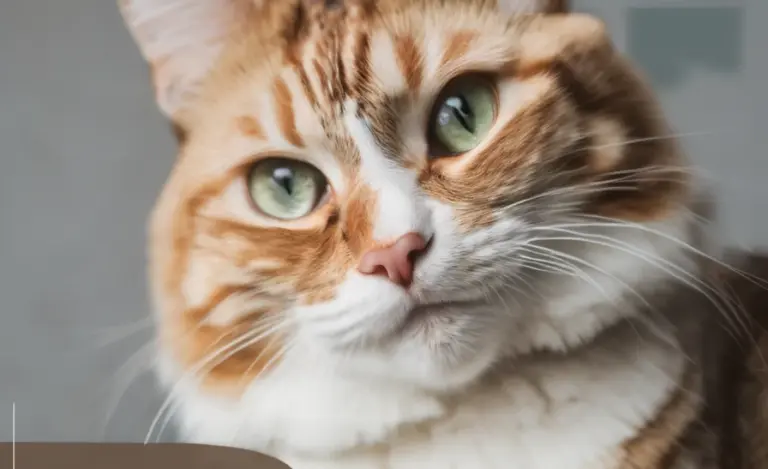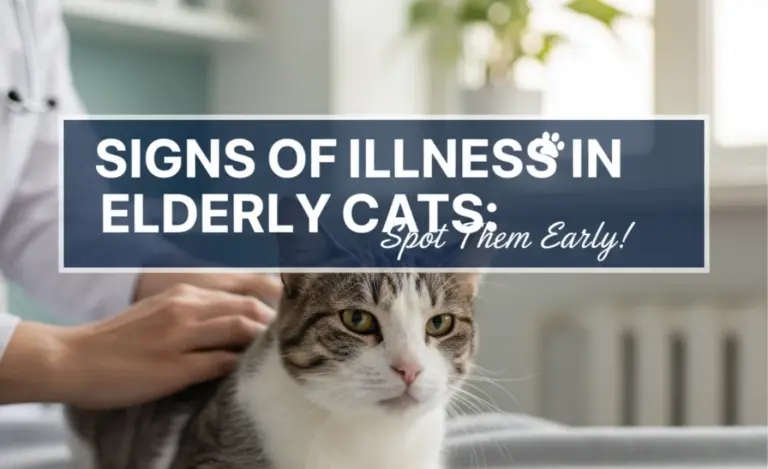Senior Cat Skin Care: The Ultimate Guide
Senior cats need special skin care due to decreased oil production and thinner skin. Regular, gentle grooming with soft brushes helps stimulate circulation and remove dead skin. Use vet-approved, hypoallergenic shampoos sparingly, and consider supplements like omega-3 fatty acids to support skin health. Watch for signs of skin issues like dryness, lumps, or excessive scratching, and consult your vet promptly.
As our beloved British Shorthairs gracefully age, their needs change. Just like us, their skin becomes more delicate and prone to issues. You might notice your senior kitty’s fur isn’t as lustrous as it once was, or their skin seems drier. It’s a common concern for us cat parents, and it’s often frustrating to see our furry friends uncomfortable. But don’t worry! With a few simple adjustments to their care routine, you can keep your senior cat’s skin healthy and comfortable.
In this guide, I’ll walk you through the essential steps for senior cat skin care. We’ll cover everything from grooming and bathing to diet and recognizing potential problems. By the end, you’ll feel confident in providing the best possible care for your aging feline companion. Let’s get started!
Understanding Senior Cat Skin Changes
As cats enter their senior years (typically around age 11 or older, according to the American Veterinary Medical Association), their skin undergoes several changes. These changes make them more susceptible to various skin conditions.
Common Skin Changes in Senior Cats
- Decreased Oil Production: Senior cats produce less sebum, the natural oil that keeps their skin moisturized. This can lead to dry, flaky skin.
- Thinner Skin: The skin becomes thinner and less elastic, making it more vulnerable to injury and irritation.
- Reduced Immune Function: The immune system weakens with age, increasing the risk of infections and allergic reactions.
- Decreased Grooming: Senior cats may groom themselves less effectively due to arthritis or other mobility issues, leading to matting and poor hygiene.
Why These Changes Matter
These changes can significantly impact your cat’s comfort and overall health. Dry, itchy skin can cause discomfort and lead to excessive scratching, potentially causing skin damage and secondary infections. Reduced grooming can result in matted fur, which can be painful and harbor bacteria.
Understanding these changes is the first step in providing appropriate skin care for your senior cat. Now, let’s look at how to address these changes through proper grooming.
Grooming Your Senior Cat
Grooming is a crucial part of senior cat skin care. It helps remove dead skin cells, stimulates circulation, and distributes natural oils. However, senior cats require a gentler approach.
Choosing the Right Grooming Tools
Using the right tools is essential to avoid irritating your cat’s sensitive skin.
- Soft-Bristled Brush: Opt for a brush with soft, flexible bristles. This will gently remove loose fur and debris without scratching the skin.
- Wide-Toothed Comb: A wide-toothed comb is useful for detangling mats and knots, especially in long-haired breeds like British Shorthairs.
- Damp Cloth: A soft, damp cloth can be used to wipe away dirt and grime, especially if your cat dislikes baths.
Grooming Techniques for Senior Cats
- Start Slowly: If your cat isn’t used to being groomed, start with short sessions and gradually increase the duration.
- Be Gentle: Use gentle, slow strokes. Avoid pulling or tugging on their fur.
- Focus on Problem Areas: Pay attention to areas prone to matting, such as the underbelly, hind legs, and around the ears.
- Check for Lumps and Bumps: Grooming provides an excellent opportunity to check for any unusual lumps, bumps, or skin irritations.
- Reward Your Cat: Offer treats and praise during and after grooming sessions to create a positive association.
Grooming Frequency
The frequency of grooming depends on your cat’s coat length and individual needs. Generally, aim to groom your senior cat at least a few times a week. Long-haired cats may require daily grooming to prevent mats and tangles.
Next, we’ll explore the importance of bathing and how to do it safely and effectively.
Bathing Your Senior Cat
While cats are generally self-cleaning, occasional baths may be necessary, especially for senior cats who may have difficulty grooming themselves. However, over-bathing can strip the skin of its natural oils, so it’s important to do it correctly.
When to Bathe Your Senior Cat
You should only bathe your senior cat when necessary, such as when they are visibly dirty, have a strong odor, or have a skin condition that requires medicated baths. Avoid bathing them too frequently, as this can dry out their skin.
Choosing the Right Shampoo
Selecting the right shampoo is crucial for maintaining your cat’s skin health.
- Hypoallergenic Shampoo: Opt for a hypoallergenic, fragrance-free shampoo specifically formulated for cats.
- Oatmeal Shampoo: Oatmeal shampoos can help soothe dry, itchy skin.
- Medicated Shampoo: If your cat has a skin condition like dermatitis or a fungal infection, your veterinarian may recommend a medicated shampoo.
Step-by-Step Bathing Guide
- Prepare the Bathing Area: Choose a warm, draft-free room. Gather your shampoo, towels, and a non-slip mat for the tub or sink.
- Brush Your Cat: Brush your cat thoroughly before bathing to remove any mats or loose fur.
- Wet Your Cat: Use lukewarm water to wet your cat gradually, avoiding their face and ears. A handheld showerhead or pitcher works well.
- Apply Shampoo: Gently massage the shampoo into your cat’s coat, working from head to tail. Avoid getting shampoo in their eyes and ears.
- Rinse Thoroughly: Rinse your cat thoroughly with lukewarm water until all traces of shampoo are gone. Residue can irritate their skin.
- Dry Your Cat: Gently towel-dry your cat, and then use a low-heat hair dryer if they tolerate it. Be sure to keep the dryer moving to avoid overheating.
- Keep Your Cat Warm: Keep your cat in a warm, draft-free area until they are completely dry.
Alternatives to Full Baths
If your cat strongly dislikes baths, consider using alternatives like:
- Wipes: Pet-friendly wipes can be used to clean specific areas of your cat’s body.
- Dry Shampoo: Dry shampoo can help absorb excess oil and dirt without the need for water.
- Spot Cleaning: Use a damp cloth to clean any soiled areas.
Now, let’s discuss the role of nutrition in maintaining healthy skin for your senior cat.
Nutrition for Healthy Skin
A balanced diet is essential for maintaining healthy skin and fur in senior cats. Certain nutrients play a crucial role in skin health.
Key Nutrients for Skin Health
- Omega-3 Fatty Acids: Omega-3 fatty acids help reduce inflammation and promote healthy skin and coat. Sources include fish oil and flaxseed oil.
- Vitamin E: Vitamin E is an antioxidant that helps protect skin cells from damage.
- Vitamin A: Vitamin A is essential for skin cell growth and repair.
- Zinc: Zinc is important for wound healing and maintaining skin integrity.
- Protein: Adequate protein intake is necessary for skin cell production and repair.
Choosing the Right Food
When selecting food for your senior cat, look for options that are:
- Specifically formulated for senior cats: These foods are typically lower in calories and higher in fiber to support healthy weight management and digestion.
- High-quality protein sources: Look for foods that list meat, poultry, or fish as the primary ingredient.
- Rich in omega-3 fatty acids: Some senior cat foods are supplemented with fish oil or other sources of omega-3 fatty acids.
Supplementing Your Cat’s Diet
If your cat’s diet isn’t providing enough of the key nutrients for skin health, you may consider supplementing their diet. Consult with your veterinarian before adding any supplements to ensure they are safe and appropriate for your cat.
| Supplement | Benefits | Dosage | Considerations |
|---|---|---|---|
| Omega-3 Fatty Acids | Reduces inflammation, promotes healthy skin and coat | Follow product label instructions or veterinarian’s recommendation | Choose a high-quality fish oil supplement |
| Vitamin E | Antioxidant, protects skin cells from damage | Follow product label instructions or veterinarian’s recommendation | Ensure it’s formulated for cats |
Next, let’s talk about how to identify and address common skin problems in senior cats.
Recognizing and Addressing Skin Problems
Senior cats are more prone to skin problems due to their weakened immune systems and thinner skin. It’s important to be vigilant and recognize the signs of skin issues early on.
Common Skin Problems in Senior Cats
- Dry Skin: Dry, flaky skin is a common problem in senior cats due to decreased oil production.
- Allergies: Senior cats can develop allergies to food, pollen, or other environmental factors, leading to itchy skin and inflammation.
- Skin Infections: Bacterial or fungal infections can occur due to weakened immune systems or skin damage from scratching.
- Parasites: Fleas, mites, and other parasites can cause intense itching and skin irritation.
- Tumors: Skin tumors, both benign and malignant, are more common in senior cats.
Signs of Skin Problems
Watch out for these signs that your senior cat may have a skin problem:
- Excessive Scratching, Licking, or Biting: If your cat is constantly scratching, licking, or biting at their skin, it could be a sign of irritation or allergies.
- Hair Loss: Patchy or widespread hair loss can indicate a skin infection, allergies, or other underlying health issues.
- Redness or Inflammation: Red, inflamed skin is often a sign of infection or irritation.
- Scales or Crusts: Scales or crusts on the skin can indicate a fungal infection or other skin condition.
- Lumps or Bumps: Any unusual lumps or bumps on the skin should be checked by a veterinarian.
- Changes in Skin Color: Darkening or lightening of the skin can be a sign of certain skin conditions.
When to See a Veterinarian
If you notice any of these signs, it’s important to consult with your veterinarian promptly. Early diagnosis and treatment can prevent the problem from worsening and improve your cat’s quality of life.
Diagnostic Tests
Your veterinarian may recommend several diagnostic tests to determine the cause of your cat’s skin problem, including:
- Skin Scrapings: To check for mites or other parasites.
- Fungal Culture: To identify fungal infections like ringworm.
- Allergy Testing: To determine if your cat has any allergies.
- Biopsy: To examine skin cells under a microscope and diagnose tumors or other skin conditions.
Treatment Options
Treatment options for skin problems in senior cats vary depending on the underlying cause. Some common treatments include:
- Medicated Shampoos: To treat infections or relieve itching.
- Antibiotics or Antifungals: To treat bacterial or fungal infections.
- Antihistamines or Corticosteroids: To relieve itching and inflammation associated with allergies.
- Parasite Control Medications: To eliminate fleas, mites, or other parasites.
- Surgery: To remove skin tumors.
- Dietary Changes: To manage food allergies or provide essential nutrients for skin health.
Below is a table of common skin problems in senior cats, their symptoms and potential treatments.
| Skin Problem | Symptoms | Potential Treatments |
|---|---|---|
| Dry Skin | Flaky skin, itching, dandruff | Humidifier, omega-3 supplements, moisturizing shampoo |
| Allergies | Itching, redness, hair loss | Antihistamines, special diet, corticosteroids |
| Ringworm | Circular bald patches, crusty skin | Antifungal medication, medicated shampoo |
| Fleas | Itching, scratching, visible fleas | Flea treatment, thorough cleaning of home |
Creating a Comfortable Environment
In addition to grooming, nutrition, and addressing skin problems, creating a comfortable environment for your senior cat can also help improve their skin health. Here are some tips:
Maintain a Comfortable Humidity Level
Dry air can exacerbate dry skin. Using a humidifier, especially during the winter months, can help maintain a comfortable humidity level in your home.
Provide Soft Bedding
Ensure your senior cat has access to soft, comfortable bedding. This can help prevent pressure sores and skin irritation.
Limit Exposure to Allergens
If your cat has allergies, try to limit their exposure to allergens such as pollen, dust mites, and mold. Regularly clean your home and consider using an air purifier.
Reduce Stress
Stress can worsen skin problems in cats. Provide a calm, predictable environment for your senior cat and avoid sudden changes in their routine.
By following these tips, you can help keep your senior cat’s skin healthy and comfortable, improving their overall quality of life.
FAQs
1. How often should I bathe my senior cat?
Senior cats typically only need bathing when they’re visibly dirty or have a skin condition your vet recommends treating with medicated baths. Over-bathing can dry out their skin, so aim for as little as possible—perhaps once every few months unless otherwise advised.
2. What kind of brush is best for grooming a senior cat?
Choose a brush with very soft, flexible bristles. These are gentle on older cats’ sensitive skin, helping to remove loose fur and stimulate circulation without causing irritation.
3. Are there any foods that can improve my senior cat’s skin health?
Yes! Look for foods rich in omega-3 fatty acids (like fish oil), vitamin E, vitamin A, and zinc. These nutrients help maintain skin integrity and reduce inflammation. Senior-specific formulas often include these beneficial ingredients.
4. How can I tell if my senior cat has a skin problem?
Watch for excessive scratching, licking, or biting; hair loss; redness or inflammation; scales or crusts on the skin; and any unusual lumps or bumps. If you notice any of these signs, it’s best to consult with your veterinarian.
5. What should I do if my senior cat hates being groomed?
Start slowly and make it a positive experience. Begin with short sessions, use gentle strokes, and offer treats and praise. If they really resist brushing, try using a damp cloth to gently wipe their coat instead.
6. Can I use human shampoo on my senior cat?
No, human shampoos aren’t formulated for cats and can be harmful. Always use a shampoo specifically designed for cats, preferably one that’s hypoallergenic and fragrance-free to avoid skin irritation.
7. Should I give my senior cat supplements for their skin?
Supplements like omega-3 fatty acids can be beneficial, but it’s always best to consult with your veterinarian before adding anything to your cat’s diet. They can help you determine the right dosage and ensure the supplement is safe for your cat’s specific needs.
Conclusion
Caring for your senior British Shorthair’s skin requires a gentle and attentive approach. By understanding the changes that occur with age, choosing the right grooming tools and techniques, providing a balanced diet, and recognizing potential skin problems early on, you can help keep your feline friend comfortable and healthy. Remember, regular check-ups with your veterinarian are essential for maintaining your senior cat’s overall well-being.
As a lifelong cat lover and the voice behind BritishShorthairAsk.com, I’ve seen firsthand the difference that dedicated care can make in a senior cat’s life. With a little extra attention and patience, you can ensure your British Shorthair enjoys their golden years with healthy, happy skin.





